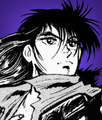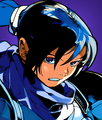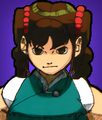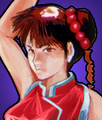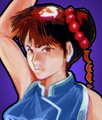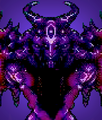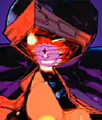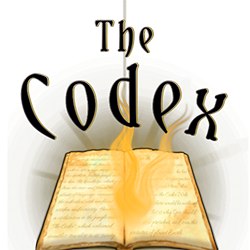The official discord link if you wish to join the discord: https://discord.gg/j5RKwCvAFu
The background art comes from Cherylann1960.
Strider: Difference between revisions
Say Abracadavre Now (talk | contribs) (Protected "Strider" ([Edit=Allow only autoconfirmed users] (indefinite) [Move=Allow only autoconfirmed users] (indefinite))) m |
m |
||
| (10 intermediate revisions by 3 users not shown) | |||
| Line 26: | Line 26: | ||
==Power of the Verse== | ==Power of the Verse== | ||
The verse has characters ranging from around '''Wall level''' to '''Building level''' with ''' | The verse has characters ranging from around '''Wall level''' to '''Small Building level''' with '''Superhuman''' travel speeds and '''Massively Hypersonic''' reaction speeds; most characters who reach Wall level scale to the average strength of a Strider, whilst those who reach Building are generally the best of the best. | ||
The verse becomes even more powerful with Strider CPS-1’s introduction of Grandmaster Meio and the Third Moon, which increases the verse's power to '''Multi-Continent level''' for the higher tiers. This verse’s general hax include [[Stealth Mastery]], [[Plasma Manipulation]], [[Energy Projection]], [[Technology Manipulation]], | The verse becomes even more powerful with Strider CPS-1’s introduction of Grandmaster Meio and the Third Moon, which increases the verse's power to '''Multi-Continent level''' for the higher tiers. This verse’s general hax include [[Stealth Mastery]], [[Plasma Manipulation]], [[Energy Projection]], [[Technology Manipulation]], etcetera | ||
==Canon== | ==Canon== | ||
| Line 78: | Line 78: | ||
===Main Timeline=== | ===Main Timeline=== | ||
<br> | |||
*'''Strider Hiryu Gaiden''' (1988) | *'''Strider Hiryu Gaiden''' (1988) | ||
*'''Strider Hiryu Manga''' (1988) | '''Strider NES Adaptation''' (1989) | *'''Strider Hiryu Manga''' (1988) | '''Strider NES Adaptation''' (1989) | ||
| Line 84: | Line 85: | ||
===Retold Timeline=== | ===Retold Timeline=== | ||
<br> | |||
*'''Strider''' (2014) | *'''Strider''' (2014) | ||
===Non-Canon=== | ===Non-Canon=== | ||
<br> | |||
*'''Strider II''' (1990) | *'''Strider II''' (1990) | ||
*'''Strider II Master System''' (1993) | *'''Strider II Master System''' (1993) | ||
| Line 92: | Line 95: | ||
==Knowledgeable Members== | ==Knowledgeable Members== | ||
<br> | |||
*[[User:SuperSaiyan2Link|SuperSaiyan2Link]] | *[[User:SuperSaiyan2Link|SuperSaiyan2Link]] | ||
| Line 120: | Line 124: | ||
File:MeioBanner.png|Grandmaster Meio|link=Grandmaster Meio | File:MeioBanner.png|Grandmaster Meio|link=Grandmaster Meio | ||
</gallery> | </gallery> | ||
[[Category:Verses]] | [[Category:Verses]] | ||
[[Category:Video Games]] | [[Category:Video Games]] | ||
| Line 126: | Line 130: | ||
[[Category:Strider]] | [[Category:Strider]] | ||
[[Category:Capcom]] | [[Category:Capcom]] | ||
[[Category:Animation]] | |||
[[Category:Manga]] | |||
Latest revision as of 16:48, 26 June 2024
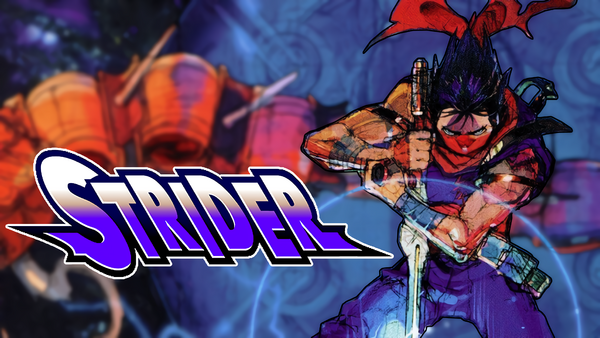
Background
Strider is a series produced by both the game development company, Capcom, and the manga artist group, Moto Kikaku. Although a lesser-known series compared to other Capcom franchises, Strider is a classic series beloved by many fans around the world. It made its debut in 1988 with the manga known simply as “Strider Hiryu”, before a year later getting a video game adaptation in the form of “Strider” for the Nintendo Entertainment System.
The Strider series tells the story of a young man named Hiryu living on a futuristic Planet Earth, as he fights against several threats posed to the planet. As a Special A Ranking member of the Strider Organization, Hiryu is tasked with saving the planet again and again, oftentimes against an extraterrestrial entity known as Grandmaster Meio. Aside from the stories told through manga, the gameplay of the Strider series are hack-and-slash platformers.
Each installment in the Strider series is set within the same continual universe, with the only notable exception being “Strider (2014)”, which is a reboot/retelling of the main universe. Every game follows Hiryu, although other characters are rarely playable.
The main recurring rival of the Strider series is an extraterrestrial entity who appeared on Earth not long after Hiryu’s first few adventures. This entity is known as Grandmaster Meio, who is planning on wiping out all life on the Planet using his gigantic space station, the Third Moon. After wiping out the Earth, he would go on to collect his artificial lifeforms using a machine known as the Caduceus, and travel the galaxy in search of a new planet to overtake. Meio is assisted by a fallen Strider and Hiryu’s rival; a man named Hien.
Terms
- Strider: A group of highly-trained, freelance mercenaries who have no allegiance to anyone except their employer. Striders are masters of stealth and combat, with even the lowest ranking Strider equalling the power of an entire special forces unit. Ranks range from “C” Rank, to “Special A” Rank.
- Cypher: The weapon that denotes a Strider, these weapons are blades similar in appearance to a broadsword, but usually held with a reverse grip. The blades of the Cyphers are made of pure plasma energy, and give off massive volts of electricity. When charged or powered up enough, Cyphers are capable of launching projectiles.
- ZAIN Project: A large-scale project codenamed “ZAIN”, which had been under development for around 30 years. Using microchips implanted in the necks of their victims, the ZAIN Project would essentially brainwash the entire population of Earth. This project was created by a man named Faceas Clay, who planned on using it to take control over all of humanity, and take his place as the god of the Earth.
- Third Moon: A gigantic space station built by the devious Grandmaster Meio, which asserts power and dominance over the citizens of Earth. Using its Anti-Gravity Device, the Third Moon was able to be lifted into Earth’s orbit, hovering menacingly over the planet. With the Third Moon, Meio has the power to wipe out all life from the planet whenever he chooses.
- Caduceus: An artificial lifeform created by Grandmaster Meio, which is said to dwarf the entire planet. Used as a bio-organic weapon, the Caduceus’s purpose was to collect all of Meio’s artificial lifeforms from around the world, and carry them across the galaxy to a new planet; all the while the Third Moon would destroy Earth following its departure.
- Trick: A list of special abilities that can be acquired by Hiryu throughout his missions. These abilities, known as Tricks, grant him elemental techniques that he can either use by himself, or channel through his Cypher; ranging from fire and electricity, to restoring the user’s health and causing earthquakes.
- Options: A set of robots that are scattered throughout the world, and accompany whoever picks them up. Options are completely robotic, but resembling real-life organisms such as mushrooms, tigers, and birds. The main purpose of an Option is to not only protect the one who summoned them, but to attack their enemies as well.
Power of the Verse
The verse has characters ranging from around Wall level to Small Building level with Superhuman travel speeds and Massively Hypersonic reaction speeds; most characters who reach Wall level scale to the average strength of a Strider, whilst those who reach Building are generally the best of the best.
The verse becomes even more powerful with Strider CPS-1’s introduction of Grandmaster Meio and the Third Moon, which increases the verse's power to Multi-Continent level for the higher tiers. This verse’s general hax include Stealth Mastery, Plasma Manipulation, Energy Projection, Technology Manipulation, etcetera
Canon
The canon timeline of the games are fairly straightforward, as the chronology of the events is generally laid out in the manga, and in the case of the games you can usually base the timeline off of release order. The timeline below will thus be laid out as such.
There are, however, some misconceptions when it comes to the canonicity of the 2014’s Strider, as well as the mystery behind Main Timeline Hiryu’s age.
If you click Expand, you will see an explanation to both of these questions, and how they will be handled on this wiki:
Main Timeline
- Strider Hiryu Gaiden (1988)
- Strider Hiryu Manga (1988) | Strider NES Adaptation (1989)
- Strider CPS-1 (1989)
- Strider 2 (2000)
Retold Timeline
- Strider (2014)
Non-Canon
- Strider II (1990)
- Strider II Master System (1993)
- Journey From Darkness: Strider Returns (1993)
Knowledgeable Members
Characters
Strider Organization
-
Hiryu
-
Cain
-
Sheena
-
Mariya
-
Hien
Kuniang Team
-
Tong Pooh
-
Pei Pooh
-
Sai Pooh
ZAIN Project
-
Yggdrasil
Otherworldly
-
Grandmaster Meio


